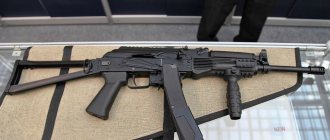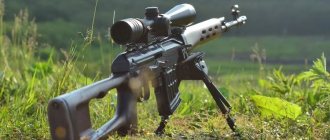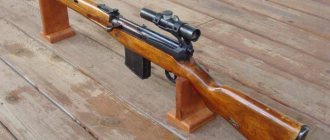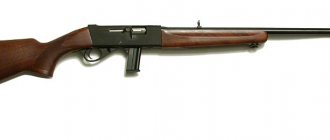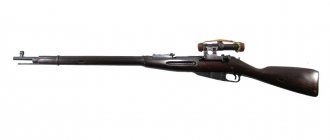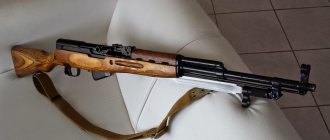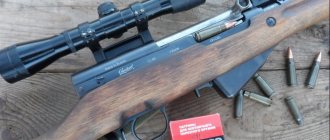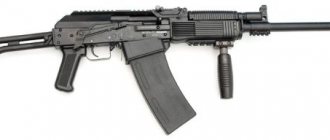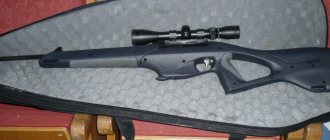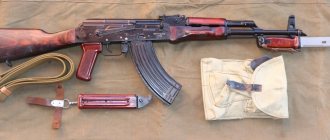The Berkut carbine, in fact, is a glorified SVD sniper rifle, converted for commercial and amateur hunting tasks.
It is typical for the armies of all countries to adopt modern types of weapons and military equipment. This process of adopting new types of small arms into service in most developed countries is constant, so the question arises: “What to do with models that have been removed from service, but are in large quantities in warehouses?” Destroy or find another use for them? The answer is obvious: it is best to convert military weapons into civilian ones, into sporting and hunting weapons, for example!
A successful example of this approach should be considered the hunting self-loading carbine "Berkut", created by employees of the Tula enterprise State Unitary Enterprise Design Bureau "Instrument Making" on the basis of the famous SVD sniper rifle.
Receiver of the Berkut carbine. Right view. The artistic design is traditional for TsKIB
"Berkut" is a model for powerful domestic cartridges 7.62x51mm, 7.62x54R and 9x53 mm, produced in series. The main purpose of the carbine is commercial and amateur hunting. "Berkut" has a gas-type automatic system. The sight is open and optical. The stock is made in accordance with the requirements of modern design. The stock material is high-quality walnut wood. For ease of transportation, the carabiner can be easily disassembled into two parts.
The forend, also made of walnut, is covered with an anti-slip notch and decorated with inlay
The surface of the receiver is decorated with engravings with scenes from the life of animals and floral patterns.
The manufacturability and cost of the Berkut carbine is at the level of well-known hunting carbines created on the basis of army models of AKM and SVD military small arms.
"Berkut" is a whole family of carbines chambered for various cartridges. The characteristics of specific samples are presented in Table 1.
The Berkut-2M1 and Berkut-2M2 carbines can use a ten-round magazine from a Tiger carbine or an SVD sniper rifle.
Carbine "Berkut" in a wooden case
Victor RON. photo by the author
History of creation
The development of the Berkut carbine began in 1998. It was decided to use the VSK-94 special-purpose sniper rifle as a prototype. However, this weapon fired 9x39mm ammunition, which is not a very common cartridge among hunting enthusiasts. So the chamber and barrel were converted to fit the classic Soviet 7.62x39 caliber ammunition. But less than a year has passed since the Berkut-2 version appeared, “powered” by NATO .308 Win cartridges (7.62x51 mm).
Despite the fact that the Berkut positioned itself as a hunting rifled carbine with a gas engine (semi-automatic reloading), it was never able to become a worthy competitor for the Simonov self-loading carbine (SKS), Tiger or Saiga-308 - too much The new model turned out to be non-standard and very expensive. So the arms factory decided not to delay the production of modifications for various cartridges, and also launched the production of several versions that satisfy the requirements of both the average Russian hunter and a wealthy collector.
Birth of the Berkuts. How Soviet rocket ships were created
New times - new weapons
With the outbreak of the Cold War in the late 1940s, the USSR found itself in a difficult situation. The country had a long sea border, and the United States and Great Britain had powerful fleets. It was necessary to somehow protect the borders, but after the battles with the Germans, the USSR had few warships left, and their construction cost huge amounts of money, which the devastated country did not have.
From "Orion" to "Hunter". How Russian drones work
The Russian Orion unmanned aerial vehicle is actively used in Syria, and the attack drone...
December 29 16:09
It was necessary to find a quick and relatively cheap solution. The fleet was replenished thanks to the massive construction of Project 613 diesel-electric submarines, 30-bis destroyers and artillery cruisers of the Chapaev and Sverdlov types. However, these were ships that were not fundamentally different from those that took part in the hostilities of World War II.
In the post-war USSR, the emphasis was placed on the development of missile weapons, which became a successful response to the giant armadas of US Air Force bombers. The missile systems were based on land, they were used to arm aviation, so it was logical to create ships equipped with missile weapons.
The start of work was authorized by Nikita Khrushchev.
The first Soviet missile cruisers “Grozny”, “Admiral Fokin”, “Varyag” and “Admiral Golovko” (“Project 58”), which entered the fleet in 1962-65, were, in fact, “fattened” destroyers - as a basis The Soviet destroyer type 57-bis (“Gnevny”) was taken from their project.
Soviet sailors were not entirely satisfied with the Grozny class ships. They were criticized for insufficient anti-aircraft, artillery and anti-submarine weapons, and for their relatively short cruising range. All these shortcomings stemmed from the small size of the “fifty-eighths”.
The fleet needed a larger cruiser.
The first of the "golden eagles"
On December 30, 1961 (before the completion of work on the “formidable”), the Central Committee of the CPSU and the Council of Ministers of the USSR adopted Resolution No. 1180-510, which became the basis for the development of a new project - 1134 (“Berkut”).
"Alexander" against "Napoleon": how a Russian brig defeated the French squadron
On December 29, 1806, the sailors of the Russian fleet won one of their most significant victories. Russian…
December 29 10:49
The work took place at the TsKB-53 design bureau (now OJSC Northern Design Bureau in St. Petersburg) under the supervision of an experienced shipbuilder Vasily Anikiev. Officially, the class of these ships was designated in the USSR as a “large anti-submarine ship” (BOD).
The construction of Project 1134 ships began in 1964 in Leningrad - at the Zhdanov shipyard (now PJSC Severnaya Verf).
The "Berkuts" were quite impressive in size: standard displacement - 5335 tons, length - 156.2 meters, they had three decks. Each such cruiser was equipped with two boiler-turbine units with a total power of 90,000 horsepower and could reach a full speed of 33 knots. The cruising range at an economic speed of 18 knots was 5,000 miles.
Each 1134th was equipped with a whole complex of radars: MR-310U Volga, MP-500 Kliver, MR-310 Angara-A, which allowed the ship to “observe” a distance of up to 300 kilometers around itself. Incoming information flowed into the flagship command post.
To search for submarines, Titan (MG-312) all-round hydroacoustic stations and Vychegda (MG-311) target designation stations, which had a range of 8-10 kilometers, were used. In the area of the stem, sensors from the MI-110K (contact under-keel) and MI-110R (airborne) submarine detection stations based on the thermal wake were located. The equipment package also included the MG-312 Titan-1 hydroacoustic station. Two Ka-25 helicopters, each equipped with five PLAT-1 torpedoes and radio-hydroacoustic equipment, were also based on the ship.
The main armament of the Berkut-class cruisers were Volna anti-aircraft missile systems - each of them had two double-barreled launchers. The Volna complex was put into service in 1962. It was developed in parallel with the ground-based S-125 complex and was its “sea” version. The “Volna” was received by several dozen units in the USSR Navy - cruisers, large anti-submarine ships and destroyers.
Specifically for type 1134, they developed a new system for storing and loading missiles - a conveyor type. Its presence made it possible to increase the ammunition load to 32 missiles for each complex. "Volna" fired B-600 rockets - solid fuel, two-stage, created according to the aerodynamic "canard" design (with an X-shaped wing behind the tail).
The initial speed of such a missile is 600 meters per second, the firing range is 15 kilometers. When approaching a target, a radar fuse was triggered, detonating the warhead. The mass of the warhead was 60 kilograms.
Among other weapons, the Golden Eagles were equipped with five-tube torpedo tubes PTA-53-1134, equipped with Enot-2 anti-submarine torpedoes.
Later modifications
In 1966, construction of ships began according to the improved project 1134-A (“Berkut-A”). They differed from the prototype by enhanced armament - the Volna was replaced by the Shtorm missile systems, which had a longer firing range: at low altitudes - up to 22 kilometers, at high altitudes - up to 32 kilometers.
Also on 1134-A were the second generation URPK-3 Metel anti-submarine missile systems. Their ammunition consists of eight 85R guided anti-submarine missile torpedoes of 533 mm caliber with a missile range of 6 to 55 km and a homing AT-2U torpedo range of 8 km.
The further evolution of Soviet cruisers took several paths. The direct “descendants” of the Golden Eagles are the multi-purpose missile cruisers type 1164 (Atlant), the cruisers type 1144 (Orlan), and the BOD types 1155 and 1155.1 (Frigate). They are still listed in the Russian Federation fleet.
Options and modifications
The Berkut-1 carbine became the first rifle in the model series. This weapon was used as a prototype to create other, more successful modifications. Finding the progenitor of all “Berkuts” will now be quite difficult, because its production has long been discontinued. But gun stores to this day are replete with the following modifications and options:
- "Berkut-2" (from the K-93 series) - a modification that uses 7.62x51 mm cartridges for firing;
- "Berkut-2-1" (from the K-93 series) - a version of the "Berkut-2" with a magazine for 5 rounds;
- "Berkut-2M" (from the K-93-1 series) - a model chambered for 7.62x54R cartridges;
- "Berkut-3" is a rifle that uses 9×53 mm caliber ammunition for firing;
- "Berkut-3-1" - a version of the "Berkut-3" carbine with a shortened magazine (5 rounds);
- "Berkut-4" is an experimental piece version chambered for 7.62x51 cartridge (.308 Win caliber) and a bullpup stock.
And these are just those models and versions of the carbine that are produced to this day and are in greatest demand among hunters. Also, don’t forget about the one-piece copies, which are distinguished by engraving on the metal, a gilded trigger, a section on the fore-end and other decorative elements that make the rifle a work of art.
Photo of S-25 Berkut air defense system
The vertical antenna of the B-200 station of the S-25 "Berkut" complex is designed to view the airspace in the elevation plane.
Control room of the S-25 complex. In the center is the senior operator's console, on the sides are the workstations of guidance and launch operators, and in the background are air situation tablets.
Target based on the 5YA24 rocket
Similar
ZSU-23-4 Shilka. Rate of fire. Armament. Dimensions. Weight
S-75 air defense systems Dvina, Desna, Volkhov. Compound. Rockets. Damage range
ZRPK Pantsir-S1. Armament. Price. Detection range
S-350E Vityaz air defense system. Compound. Rockets. Damage range
OSA-AKM air defense missile system. Firing range. Rockets. Compound. Dimensions. Weight
ZSU 2S6M Tunguska-M. Damage range. Rockets. Compound. Dimensions
ZRK 2K12 KUB. Damage range. Rocket speed. Principle of operation
SAM Buk-M1-2. Detection and destruction range. Rockets. Possibilities
SAM S-200 Angara, Vega, Dubna. Damage range. Compound. Principle of operation
MANPADS 9K310 Igla-1. Damage range. Weight. Possibilities
SAM 9K331 Tor-M1. Damage range. Rocket. Principle of operation
MANPADS Verba. Damage range. Rocket. Composition of the complex
SAM S-125 Neva (Pechora) Range and height of destruction. Rockets
S-400 Triumph air defense system. Damage range. Rockets. How does it work
SAM 9K35 Strela-10. Damage range. Modifications. Rockets
SAM S-300PMU2 Favorite. Damage range. Compound. Rockets
SAM S-25 Berkut. Range and altitude of damage. Rockets
SAM Sosna. Armament. Damage range. Rockets. Compound
American Patriot air defense system. Damage range. Compound. Rockets
Naval air defense missile system Dagger. Damage range. Compound. Rockets. On what ships is it installed?
ZRK 2K11 Circle. Damage range. Modifications. Compound
Anti-aircraft gun ZSU-57-2. Armament. Dimensions. Booking
KTPU "Gibka" (3M-47) Damage range. Rockets. Principle of operation
"Osa-M" - shipborne anti-aircraft missile system
MANPADS 9K34 "Strela-3"
FIM-92A Stinger - American MANPADS
S-300V (9K81) - anti-aircraft missile system
9S482M7 (PU-12M7) - battery-operated mobile control station
SAM "Avenger" - American mobile anti-aircraft missile system
MANPADS 9K32 "Strela-2"
SAM M-1 "Volna" (4K90) - ship-based anti-aircraft missile system
MD-PS - anti-aircraft missile system
ZSU-37 - self-propelled anti-aircraft gun
Appearance and design of "Berkut-2M"
Considering that the Berkut-2M carbine is the most popular of the entire series, we will look at the appearance and design of the weapon specifically on it. From the very first minute of operation, the hunter will notice that this rifle is radically different from the SKS, Tiger and Saiga, although the reloading system and the ammunition used are almost identical. Here are the main design features that stand out from the general background:
- The gun is equipped with an optical sight designed for shooting at a distance of up to 300 m.
- The magazine capacity is only 5 rounds, but the Berkut-2M weighs only 3.5 kilograms.
- The double-sided safety is an extremely convenient feature for left-handed hunters.
- The bolt mechanism is locked with 4 hooks, but there is no delay when the magazine is empty.
- There are two dovetail strips for attaching additional body kit.
Berkut 2 M
The appearance of the weapon as a whole does not cause any complaints, although it was designed for an amateur. The 5-round magazine looks especially unusual against the backdrop of a 620 mm barrel. Also, some owners complained that there was a small crack between the receiver and the butt, into which various debris kept getting caught.
Tactical and technical characteristics of the S-25 Berkut air defense system
— Years of operation: 1955 - 1982 - Entered into service: 1955 - Designer: Lead developer - KB-1
Characteristics of the 1955 model system
— Target speed: 1500 km/h — Hit altitude: 5.0—15 km — Range: 35 km — Number of targets hit: 20 — Number of missiles: 60 — Possibility of hitting a target in interference: no — Missile storage life: on the launcher — 0.5 years; in stock - 2.5 years
Characteristics after modernization in 1966
— Target speed: 4200 km/h — Hit altitude: 1500–30000 m — Range: 43 km — Number of targets hit: 20 — Number of missiles: 60 — Possibility of hitting a target in interference: yes — Missile storage life: on the launcher — 5 years; in stock - 15 years
Shooting Features
But it is difficult to evaluate a weapon only by appearance, because it is much more important to pay attention to how the carbine behaves during shooting. If we talk about combat characteristics in comparison with the “Tiger”, then the difference in performance will be significant. For example, the civilian analogue of the SVD can boast a muzzle energy of 3500 J, while the Berkut has this parameter only 2800 J. Although it should be noted that the latter’s recoil is much less, since a huge part of the energy is spent on operating the gas engine.
But the open sight of the Berkut is clearly more convenient than that of the Tiger or SKS. The front sight of the weapon is thicker, so the target will be “caught” by it much faster. So if we consider the Berkut carbine from the point of view of a weapon for competitions, then it will win over its competitors, and by a large margin. However, this, unfortunately, cannot be said about the four-fold optical sight, which can only be called a sniper sight at a stretch. When shooting from long distances, the original Berkut would not have a chance against the Tiger or even the Saiga.
Thus, the Berkut is a much more preferable weapon for training than other carbines, because it has low recoil, low power and a convenient open front sight. But if we consider the rifle as a weapon for hunting, and even compare it with carbines such as SKS and Tiger, then the Berkut will not have a chance.
Disassembly
Judging by the reviews of the owners, disassembling the Berkut-2M self-loading hunting carbine does not cause any particular difficulties. All the necessary work can be done by following a simple algorithm of actions:
- We disconnect the magazine and make sure that there is no ammunition left in the cartridge.
- We fold back the spring-loaded latch located at the top of the handle.
- Moving backwards, we remove the butt with the body and trigger mechanism.
Further (complete) disassembly should be carried out only if it is necessary to repair the weapon or replace a part. Here's a little instruction:
- Take a flathead screwdriver and use it to pry off the return spring.
- We remove the return spring from the receiver.
- Disconnect the bolt carrier from the receiver.
As you can see, although disassembly is not particularly difficult, it may seem unusual for most hunters. However, if you are the former owner of a Browning, then all the above actions will seem simply primitive.
conclusions
For a Russian hunter who is accustomed to using carbines with reliable military systems (SKS, Tiger, Saiga, Vepr), the Berkut-2M will seem like an extremely non-standard weapon that requires special treatment. However, it should be noted that the rifle fully copes with the tasks assigned to it. This is especially true for those carbines that are equipped with more advanced optics than the standard four-fold sight.
The build quality also does not cause any particular complaints, except in those cases when buyers came across models with a gap between the chamber and the barrel. The weapon can be safely used in almost any weather conditions, and the barrel does not rust, even if it is completely neglected for maintenance (thanks to the chrome coating). Well, piece carbines generally have an ideal quality, in no way inferior to the collectible Saiga.
The most important thing to remember when purchasing a Berkut is that the carbine is not intended for long-range shooting. Even if you install good optics on a weapon, this will not help in any way to solve the problem of poor accuracy (scatter of about 35 cm at a distance of 400 meters). However, if you do not plan to shoot from a long distance, then you can consider the Berkut as a weapon for hunting.
Yes, the Berkut-2M is in many ways inferior to the Tiger and SKS, but the weapon cannot be called definitely bad. It’s just that this carbine is more suitable for novice hunters who, in addition to hunting, regularly train in clay pigeon shooting. Also, the one-piece version, which can be purchased at a very reasonable price, will be an excellent addition to any collection. Well, for those hunters who love non-standard weapons, the “Berkut” will seem ideal.


